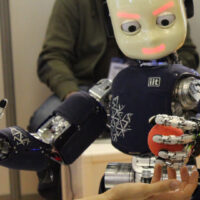The season of festive celebration is upon us! With the semester of teaching ID at Virginia Tech behind me, I’m thoroughly enjoying my extended moments of family, fellowship, and food! So when my daughter Phoebe got inspired to make a batch of cookies the other day, I was all in! Being the creative type that we are, I knew we’d never settle for the basic run of the mill round-n-rise (I made that up by the way) variety of cookie! Nope, rather we set our sights on cookies that would be playful and festive in form. When Phoebe declared that a cute little deer fawn was to grace our festive ensemble, the hunt was on. Our quick trip to our local Hobby Lobby was to no avail, no fawn. What to do?
Ahh, SkillCoach to the rescue! Armed with Onshape for my 3D CAD modeler and a Creality Ender3 3D printer, I set to save the day and set to work making our very own custom on-demand cookie cutter. In the end, we “Got-R-Done!” The remainder of this post is a snapshot of the creative flurry that ensued and the tasty treats that followed.
Onshape 3D CAD Modeling of Cookie Cutter
As mentioned I used the cloud-based 3D CAD software to model our cookie cutter. The actual model build time was approximately one hour. The video below has been edited to 14 minutes. My goal at the time was to keep the process moving and get cookies in the oven! Hence, during the model build, I employed a little improvisation. I mixed and matched various tools and techniques as I constructed the geometry. I may post the unedited version to my Vince Haley_SkillCoach Youtube channel at a later date.
All I Want Is Some Treats
Now if pushing pixels, modeling splines or 3D printing plastic is not your idea of creative festivities, but making and munching on some fresh baked cookies is, not to worry. I’ve included the recipe Phoebe used and a few in-process pics.


Utensils for measuring. 
Mixing ingredients
Art to Part Workflow
Step 1 – Prepare Reference Art

First up, prepare the artwork for importing into the Onshape CAD modeling environment. I chose to use Adobe Photoshop and push a few pixels around in this example. An alternative would be to prepare vector art in .DXF or .DWG format using Adobe Illustrator or freeware such as Inkscape. The beauty of vector over pixels is that when imported into Onshape vector art is ready to go, the step of manually tracing around background art to create the 2D sketch is not required. Both workflows have their pros and cons.
Sketch and scan, or download your reference art, whichever works for you. The key is to have enough contrast between the subject (fawn in my example) and the background. The enhanced edge detail will make the Onshape CAD tracing process somewhat easier. Additionally, trim the boundary of the image close to the subject on all sides and adjust the image size to have a vertical or horizontal dimension that is close to the size you desire your cutter to be. My target was a four-inch-tall cookie. Finally, save the image out in either .PNG or a .JPEG format and you’re ready to move on to the next step.
Step 2 – 3D CAD Model Construction
Reference the video at the head of this post for step-by-step model geometry build.

Step 3 – Prepare CAD for 3D Printing
After completing the construction of the model in Onshape, I exported the file out in the .STL format. Using Simplify3D a 3D print slicing program, I prepared the cookie-cutter geometry for 3D printing. The software slices the model in layers and produces the gcode needed by the 3D printer. Given we were chomping at the bit to try out our custom cutter, I decided to use what’s known as “Vase Mode” which is one of the fastest ways to produce prints. Vase mode prints the outer boundary of an object in a continual spiraling motion.



Step 4 – 3D Printing
The fun part was firing up the 3D printer! Over the summer I purchased two Creality Ender3 3D printers and I’ve been putting them to good use. Although this model is an entry-level product, it’s a pretty good price to performance ratio. I’ve upgraded mine by adding an OEM Creality glass bed, TL Smoothers stepper motor electronics, and a SeeMeCNC EZR Struder™ filament extruder. By printing in vase mode we had our first print in just shy of one hour!

Once Phoebe was set for baking, I went back into Simplify3D and scale up the cookie by 125% and resliced the model. Our new-build time was a little over 5 hours owning to using more infill, more layers. Yet, overall it yielded a bigger and stronger cutting utensil.

Well, there’s a peek at our creativity flurry! I’ve enjoyed sharing a little of the processes, tools, and CAD modeling techniques. I trust you’ve been able to glean a morsel or two to help you in your creative pursuits.
Until next time, keep learning!









